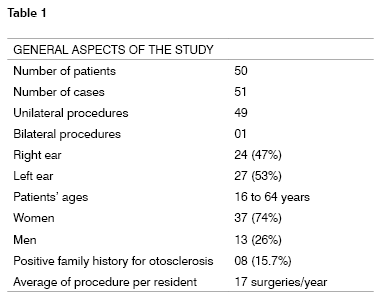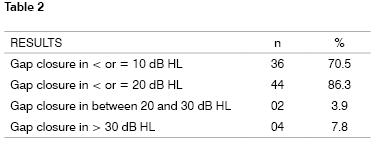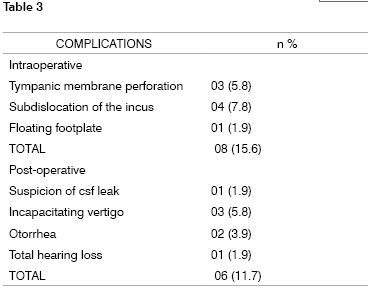

Year: 2006 Vol. 72 Ed. 6 - (2º)
Artigo Original
Pages: 727 to 730
Surgical treatment of otosclerosis in medical residency training
Author(s): Vinicius Antunes Freitas1, Celso Gonçalves Becker2, Roberto E. S. Guimarães3, Paulo Fernando Tormin B. Crosara4, Gabriela Amélia Nassif Morais5, Marcelo Moura6
Keywords: surgery, stapedotomy, otosclerosis, medical residency.
Abstract:
The number of patients with stapes otosclerosis compared to the number of otorhinolaryngologists has declined over the past several years. As a result a controversy has arisen in the literature, whether or not stapes surgery should be included in residency programs. Aim: the objective of the present study is to evaluate the results and complications of estapedotomies performed by residents between January, 1997 and January, 2000, and consequently study the feasibility of including estapedotomies in residency programs. Study design: retrospective review of prospectively collected audiometric data. Materials and methods: fifty charts of patients that were submitted to a total of 51 primary stapedotomies were reviewed mainly for complications and audiological results. Results: there was closure of the air-bone gap within 10 dB HL in 70.5% of ears and closure to within 20 dB HL in 86.3% of ears. There was one ear with total hearing loss (2%). Conclusion: From the results and complications seen in the present study, and analyzing papers from the literature, it is possible to conclude that stapedotomy is a procedure that can be included in residency programs, if there are surgical cases for the residents.
![]()
INTRODUCTION
Otosclerosis is a pathological process located in the otic capsule. It rarely involves the ossicles and it may cause secondary effects to both the auditory and the vestibular systems, causing conductive and/or sensorineural hearing loss. This hearing loss usually starts between 15 and 35 years, and is a dominant autosomal disease of variable manifestation.1,2
The surgical treatment for otosclerosis has been increasingly less indicated to treat the disease because of a reduction in the number of patients, either because of the efficacy of prior treatments, by the use of hearing aids or even because of fluoride used in the drinking water2-9. The mobilization of the stapes to treat otosclerosis was first advocated by Rosen, in 1952 and later modified by Shea in 1958.9,10 Various techniques have been developed along the years, and the current trend is to replace total stapedectomies with stapedotomies, with reports of better closure of the air-bone gap in the high frequencies and better speech recognition after the procedure, although some authors have found similar results with both techniques. 10-15
The success of the otosclerosis surgical treatment depends, according to many authors, more on the surgeon's experience than the technique itself, and some have questioned residents' training in stapes surgeries.9,12,16,17
A good surgical result is achieved when the air-bone gap is rendered smaller or equal to 10 dB in 90% of the cases and with less than 1% of severe sensorineural hearing loss in the post-operative time, regardless of the technique used.3,12
Our paper aims at assessing the results and complications regarding patients who underwent stapes surgeries carried out by residents at the University Hospital of the Federal University of Minas Gerais (HC-UFMG).
MATERIALS AND METHODS
We carried out a retrospective assessment of the charts belonging to 50 patients who underwent stapes surgeries at the University Hospital - HC-UFMG, from January 1997 to January of 2000. Inclusion criteria were: primary stapedotomy; patients with charts bearing all the clinical, surgical and audiological information; and surgeries carried out by residents. Exclusion criteria were: second look surgeries, surgeries performed by the preceptors and patients whose charts lacked the necessary information.
The technique used was stapedotomy by making an endaural tympanomeatal flap, curettage of the bony angle in order to visualize the following structures: incus-stapes joint, facial nerve, chorda tympani nerve, cochleariform process and pyramidal process. After measuring and finding the proper length of the prosthesis, we proceeded with the fenestration with a 0.6mm manual perforator, cutting the stapes tendon, incus-stapes joint separation and fracture of the stapes cruras. The prosthesis is then implanted and cut and it is padded with gelfoam® , at the end the tympanomeatal flap is pushed back to its position. The prosthesis implanted were the Aldo Stamm® model, 60.8% of 0.45mm in diameter and 39.2% of 0.3mm in diameter.
The residents perform this type of surgery in their third year of training and after they spend two years practicing at the temporal bone dissection lab, during which time they improve their ear surgery skills by performing other types of otologic surgeries as well such as tympanoplasties, ossiculoplasties and mastoidectomies. These residents have the support and help of an otologic surgeon. Whenever necessary, the preceptor interfered and corrected problems, helped them develop the technique and ended the surgery in a time that would make the procedure safe for the patients.
All audiometries were performed by speech and hearing specialists and were supervised by otorhinolaryngologists, using an Amplaid® 309 audiometer. The preoperative audiometries were performed 2 months before the surgery and the post operative audiometry was the last one found in the patient's chart and was carried out between 3 months and 3 years after the procedure.
The surgical result was subjectively assessed as the patient's report found in the chart and objectively by the analysis of pre and postop audiometries. The calculation of the air-bone gap closure was carried out by subtracting the preoperative bone hearing level from the postop air-conduction hearing level (average in the frequencies of 500, 1000, 2000, 4000 Hz).
RESULTS
Through the inclusion and exclusion criteria aforementioned, we found 50 patients, 49 underwent unilateral surgery and 1 patient was submitted to a bilateral procedure. There were 24 (47%) surgeries performed to the right ear and 27 (53%) to the left ear. Age varied from 16 to 64 years; 37 patients were women. The average of surgical procedures performed per resident during this time was of 17 procedures per resident /year (Table 1).
Of the operated patients, 15.7% had positive family history of otosclerosis and 82.4% had bilateral involvement.
As to the type of anesthesia, 94.1% of the procedures were performed under general anesthesia and 5.9% under local anesthesia and sedation. There were no complications related to the anesthesia itself.
Analyzing the hearing results of the 51 operated upon ears through pre and post op audiometry, the air-bone gap was reduced to less than or equal to 10 dB in 70.5% of the cases; to less than or equal to 20 dB in 86.3%; between 20 and 30 dB in 3.9% and greater than 30 dB in 7.8% of the cases. There was one case of total hearing loss, representing 1.9% of the procedures, due to suppurative otitis media in the postop. As to the subjective hearing assessment in the first three months after surgery, 86.3% of the patients reported some improvement, 5.9% reported a worsening; 5.9% reported no change and for 2% of the patients we did not find any report in these regards in their medical charts (Table 2).
The chorda tympani nerve was preserved in 74.5% of the patients. The facial nerve was exposed in 9.8% of the cases and its dehiscence was mentioned in only 2% of the cases. Bony footplate was found in 4 patients, and in three of these the gap was brought down to equal or less than 10 dB.
Transoperative complications happened in 15.6% of the patients (8 cases); 5.8% (3 cases) with tympanic membrane perforations, whom required tympanoplasties later on; 7.8% (4 cases) with subdislocation of the incus; and 1.9% (one case) with a floating footplate that had a good audiologic result (gap equal or less than 10 dB). There was no case of implant extrusion in the post operative period for these patients (Table 3).
For one patient in the immediate post-op we suspected a CSF leak with diziness that spontaneously recovered two cases (3.9%) of otorrhea; and 3 cases (5.8%) of vertigo that spontaneously resolved in three weeks. There were no cases of facial paralysis or paresis.
DISCUSSION
Surgery is one of the alternatives used to treat patients with otosclerosis. It is a procedure that requires extreme precision and delicate moves, in such a way that its training in residency programs is questionable. There is also another fact that should be taken into account, which is a reduction in the number of indications for this procedure, either because of a lower number of patients in relation to otorhinolaryngologists, or because of alternative treatment modalities (hearing aid, fluoride).2-9
At the University Hospital of the Federal University of Minas Gerais HC-UFMG, many patients with otosclerosis have been operated, and virtually all of them undergo stapedotomies because of shorter surgery duration and less need for stapes manipulation10-14. ENT residents participate in stapes surgeries, aided by a preceptor in practically all the cases operated in our institution. Since we are a reference hospital and we belong to the public health system, where a large number of patients with otosclerosis are seen (17 patients were operated per year by each resident), although the literature points towards a significant reduction in the number of cases.2-9
Vernick8 presented poor results from surgeries performed by residents, and considered unacceptable to have results below the ideal one (gap closure to less than 10 dBHL8,12,16), since this is an elective procedure which bears great repercussion in the patients' lives. House et al.12 relate a higher surgeon's experience to a lower level of complications and better post-operative results. Data presented by Vernick are in regards of stapedectomies, seen by Hughes16,17 as a procedure that requires further training in order to reach good results when compared to stapedotomies. Our results (gap closure to less than 10 dB HL of 70.5%) are lower than the desired figures, even when we only carried out stapedotomies. It is necessary to consider that there is a learning curve, and we argue if the training in the dissection lab is enough to acquire the necessary skills (all residents underwent prior training in cadaver specimens).
Some authors presented good results with inexperienced surgeons when the procedure performed is the stapedotomy with the use of laser, and even with other methods2,16. Another important debate is whether the stapes surgery is related to a surgical immaturity or immaturity towards otologic surgery in general. Hughes suggests that stapedectomy is not a procedure that can be performed sporadically, with the risk of impairing the surgical result. Since stapedotomy has a shorter learning curve than stapedectomy and there is a significant amount of procedures to be performed (about 10 cases of stapedotomy and 40 of stapedectomy), good results can be reached in less time16.
CONCLUSION
Stapes surgery requires elaborate surgical skills and experience in order to achieve good results. We propose that residents may perform such surgeries, provided that they are exposed to long trainings in the anatomy lab and in other otological procedures, and stapedotomies are the procedure of choice carried out under the supervision of an experienced surgeon. It is necessary that the residency program have a large number of cases and regularly occurring so that the resident may acquire the surgical skills acknowledged by the preceptor.
REFERENCES
1. Niedermeyer HP, Arnold W. Ethiopathogenesis of otosclerosis. ORL 2002;64:114-9.
2. Rondini-Gilli E, Grayeli AB, Boutin P, Crosara PF, Mosnier I, Bouccara D, Cyna-Gourse F, Rufat P, Sterkers. Otospongiose: techniques chirurgicales et résultats. A propos de 150 cas. Ann Otolaryngol Chir Cervicofac 2002;119(4):227-33.
3. Mathews SB, Rasgon BM, Byl FM. Stapes Surgery in a Residency Training Program. Laryngoscope 1999;109:52-4.
4. Shapira A, Ophir D, Marshak G. Success of Stapedectomy Performed by Residents. Am J Otolaryngol 1985;6:388-91.
5. Engel TL, Schindler RA. Stapedectomy in Residency Training. Laryngoscope 1984:768-71.
6. Strunk CL, Quinn FB, Bailey BJ. Stapedectomy Techniques in Residency Training. Laryngoscope 1992;102:121-4.
7. Harris JP, Osborne E. A Survey of Otologic Training in US Residency Programs. Arch Otolaryngol Head Neck Surg, 1990;116:342-5.
8. Vernick DM. Stapedectomy Results in a Residency Training Program. Ann Otol Rhinol Laryngol 1986;95:477-80.
9. Duncan NO, Jenkins HA, Wright GL, Alford BR. Stapedectomy trends for the resident. Ann Otol Rhinol Laryngol 1988;97:109-13.
10. Fisch U. Stapedotomy versus stapedectomy. Am J Otol 1982 Oct;4(2):112-7.
11. Spandow O, Soderberg O, Bohlin L. Long-term results in otosclerotic patients operated by stapedectomy or stapedotomy. Scand Audiol 2000;29:186-90.
12. House HP, Hansen MR, Al-Dakhail AA, House JW. Stapedectomy versus stapedotomy: comparison of results with long-term follow-up. Laryngoscope 2002;112:2046-50.
13. Dornhoffer JL, Bailey HA, Graham SS. Long-term Hearing results following stapedotomy. Am J Otol 1994;15:674-8.
14. Kursten R, Schneider B, Zrunek M. Long-term results after Stapedectomy versus stapedotomy. Am J Otol 1994;15:804-6.
15. Kos MI, Montandon PB, Guyot JP. Short- and Long-term results of stapedotomy and stapedectomy with a Teflon-wire piston prosthesis. Ann Otol Rhinol Laryngol 2001;110:907-11.
16. Sargent EW. The Learning Curve Revisited: Stapedotomy. Otolaryngology - Head Neck Surg. 2002;126:20-5.
17. Hughes GB. The learning curve in stapes surgery. Laryngoscope 1991;101:1280-4.
1 MD - UFMG, ENT Resident - Núcleo de Otorrino BH.
2 PhD, Assistant Professor - Department of Otorhinolaryngology, Ophthalmology and Speech and Hearing Sciences - Medical School - UFMG.
3 PhD, Assistant Professor - Department of Otorhinolaryngology, Ophthalmology and Speech and Hearing Sciences - Medical School - UFMG.
4 PhD, Substitute Professor - Department of Otorhinolaryngology, Ophthalmology and Speech and Hearing Sciences - Medical School - UFMG.
[5][5] MD - UFMG, ENT Resident - Núcleo de Otorrino BH..
[6][6] MD - UFMG, Otorhinolaryngologist.
Paper submitted to the ABORL-CCF SGP (Management Publications System) on March 21st, 2006 and approved on May 15th, 2006. cod. 1793.


